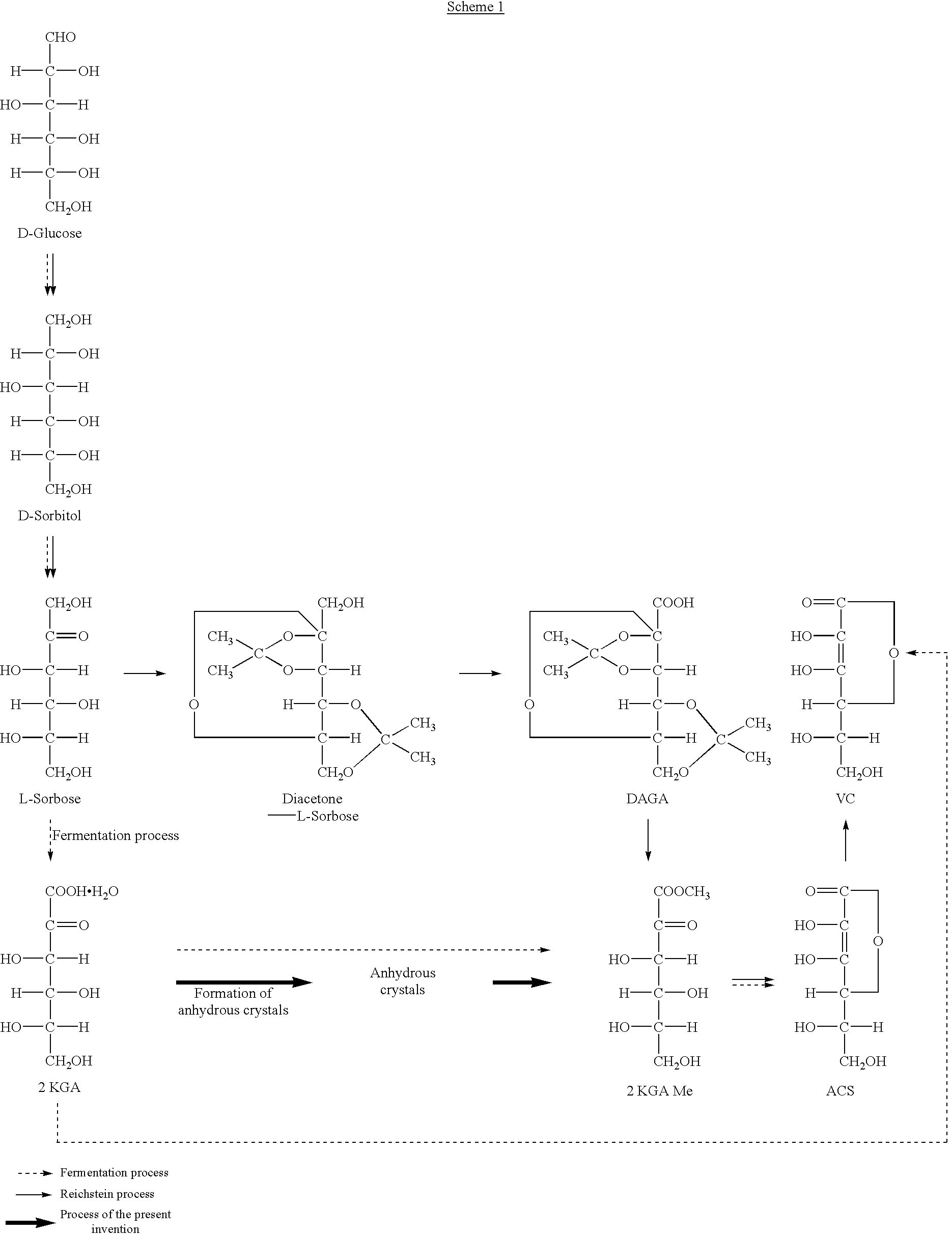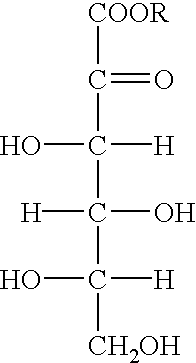Process for preparing metal ascorbate and its precursor
a technology of ascorbate and ascorbate, which is applied in the field of esterification process of 2ketolgulonic acid, can solve the problems of complicated production steps, limited yield of sodium l-ascorbate (acs), and high cost, and achieves the effects of reducing the amount of lower alcohol, improving the degree of esterification, and saving energy
- Summary
- Abstract
- Description
- Claims
- Application Information
AI Technical Summary
Benefits of technology
Problems solved by technology
Method used
Image
Examples
example 2
[0027] Four portions of dried 2-keto-L-gulonic acid monohydrate crystals (total 100 g, moisture content: 8.6%, purity: 90%) were added to methanol (75 ml) warmed at 35.degree. C. with stirring at 10 minutes intervals. After completion of the addition, the reaction was carried out at this temperature for 1 hour to form the corresponding anhydrous crystals. The reaction mixture was cooled to 5.degree. C. and the crystals formed were filtered off. The crystals were washed with methanol (15 ml). They were dried under reduced pressure to obtain 2-keto-L-gulonic acid anhydrous crystals (82.4 g, yield: 90%, purity: 99.0%, moisture content: 0.1%, color 430 nm. 20%: 0.002).
example 3
[0028] Four portions of undried 2-keto-L-gulonic acid monohydrate crystals (total 100 g, moisture content: 10.6%, purity: 88%) were added to methanol (75 ml) warmed at 35.degree. C. with stirring at 10 minutes intervals. After completion of the addition, this temperature was kept for 30 minutes to form the corresponding anhydrous crystals. The reaction mixture was cooled to 10.degree. C. and the crystals formed were filtered off. The crystals were washed with methanol (30 ml). They were dried under reduced pressure to obtain 2-keto-L-gulonic acid anhydrous crystals (80.6 g, yield: 88%, purity: 98.5%, moisture content: 0.5%, color 430 nm. 20%: 0.003).
example 4
[0029] Methanol (150 ml, moisture content: 0.02%) was added to 2-keto-L-gulonic acid anhydrous crystals (150.0 g, moisture content: 0.1%, purity: 99.0%) and the mixture was warmed to form a solution.
[0030] After the temperature of the solution was elevated to its boiling point, conc. sulfuric acid (0.3 ml) was added thereto as a catalyst. To this was added methanol (600 ml) continuously over about 3 hours, while distilling away water formed together with methanol to keep the surface of the reaction mixture at a constant level. When a small amount of seed crystals was added after 30 minutes from initiation of esterification, methyl 2-keto-L-gulonate was crystallized out. After completion of addition of methanol, methanol (300 ml) was added to the mixture and crystals were dissolved under reflux.
[0031] Then, a 10.7 wt % solution of sodium hydroxide in methanol was added dropwise over about 2 hours under reflux to lactonize the ester. After 30 minutes from initiation of addition of the...
PUM
 Login to View More
Login to View More Abstract
Description
Claims
Application Information
 Login to View More
Login to View More - R&D
- Intellectual Property
- Life Sciences
- Materials
- Tech Scout
- Unparalleled Data Quality
- Higher Quality Content
- 60% Fewer Hallucinations
Browse by: Latest US Patents, China's latest patents, Technical Efficacy Thesaurus, Application Domain, Technology Topic, Popular Technical Reports.
© 2025 PatSnap. All rights reserved.Legal|Privacy policy|Modern Slavery Act Transparency Statement|Sitemap|About US| Contact US: help@patsnap.com



